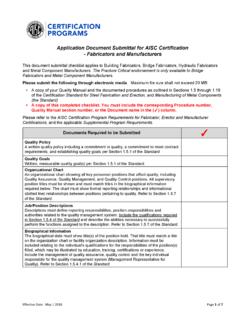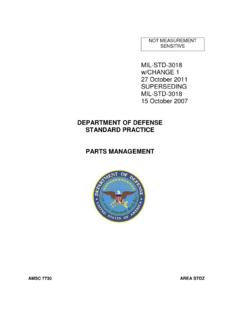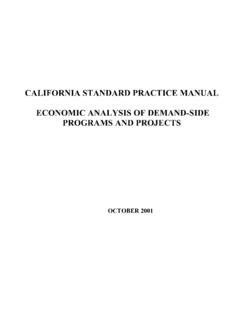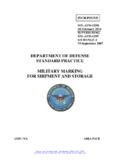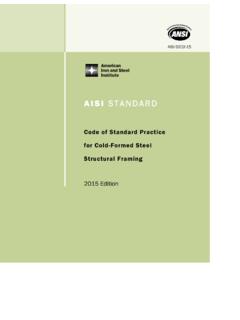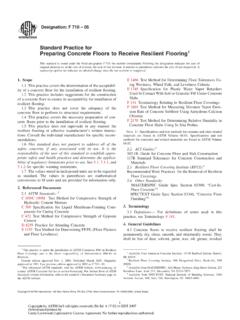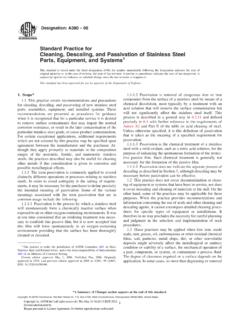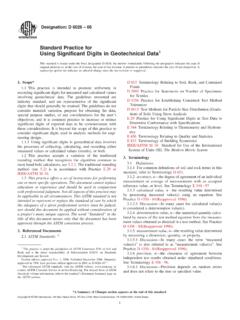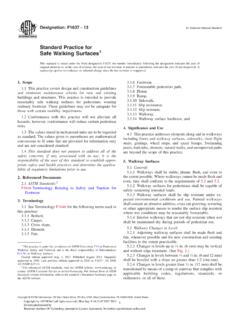Transcription of Code of Standard Practice for Steel Buildings and Bridges
1 ANSI /AISC 303-16An American National StandardCode of Standard Practice for Steel Buildingsand BridgesJune 15, 2016 Supersedes the code of Standard Practice for Steel Buildings and Bridges dated April 14, 2010 and all previous versionsApproved by the Committee on the code of Standard PracticeAMERICAN INSTITUTE OF Steel CONSTRUCTION130 East Randolph Street, Suite 2000, Chicago, Illinois AISC_PART 16_COSP_15th 2017-05-09 2:04 PM Page i (Black plate) of Standard Practice for Steel Buildings and Bridges , June 15, 2016 AMERICANINSTITUTE OFSTEELCONSTRUCTION AISC 2016byAmerican Institute of Steel ConstructionAll rights reserved. This book or any part thereofmust not be reproduced in any form without thewritten permission of the AISC logo is a registered trademark of information presented in this publication has been prepared by a balanced committeefollowing American National standards Institute (ANSI) consensus procedures and recog-nized principles of design, construction and contract interpretation.
2 This document isintended as a statement of custom and usage in structural Steel construction. Competentdesign, construction and legal advice should be sought when applying the provisions of thisdocument to a specific construction project or contract document. The publication of thisinformation is not a representation or warranty on the part of the American Institute of SteelConstruction, its officers, agents, employees or committee members, or of any other personnamed herein. All representations or warranties, express or implied, other than as statedabove, are specifically disclaimed. Anyone making use of the information presented in thispublication assumes all liability arising from such must be exercised when relying upon standards and guidelines developed by otherbodies and incorporated by reference herein, since such material may be modified oramended from time to time subsequent to the publication of this edition.
3 The AmericanInstitute of Steel Construction bears no responsibility for such material other than to refer toit and incorporate it by reference at the time of the initial publication of this in the United States of AmericaRevision May 201715 AISC_PART 16_COSP_15th 2017-05-08 2:03 PM Page ii (Black plate) of Standard Practice for Steel Buildings and Bridges , June 15, 2016 AMERICANINSTITUTE OFSTEELCONSTRUCTIONPREFACE(This Preface is not part of ANSI/AISC 303-16, but is included for informational purposesonly.)As in any industry, trade practices have developed among those that are involved in thedesign, purchase, fabrication and erection of structural Steel .
4 This code provides a usefulframework for a common understanding of the acceptable standards when contracting forstructural Steel . As such, it is useful for owners, architects, engineers, general contractors,construction managers, fabricators, Steel detailers, erectors and others associated with con-struction in structural Steel . Unless specific provisions to the contrary are contained in thecontract documents, the existing trade practices contained herein are considered to be thestandard custom and usage of the industry and are thereby incorporated into the relation-ships between the parties to a is important to note the differences in design requirements between Buildings andbridges.
5 ANSI/AISC 360 and 341 establish the design requirements for Buildings and building-like structures, and this code sets complementary commercial and technical highway Bridges , the governing design requirements are established by AASHTO andimplemented by the contracting agency; the commercial provisions of the code are appli-cable, but technical provisions, such as tolerances, are not Symbols and Glossary are an integral part of this code . In many sections of thisCode, a nonmandatory Commentary has been prepared to provide background and furtherexplanation for the corresponding code provisions. The user is encouraged to consult code is written and intended to be utilized in Practice as a unified documents may supercede individual provisions of the code as provided in , except when doing so would violate a requirement of the applicable building the first edition of this code was published in 1924, AISC has continuously sur-veyed the structural Steel design community and construction industry to determine standardtrade practices .
6 Since then, this code has been periodically updated to reflect new andchanging technology and industry 2000 edition was the fifth complete revision of this code since it was first the 2005 and 2010 editions, the 2016 edition is not a complete revision but does addimportant changes and updates. It is the result of the deliberations of a fair and balancedCommittee, the membership of which included structural engineers, architects, a code offi-cial, a general contractor, fabricators, a Steel detailer, erectors, inspectors and an following changes have been made in this revision: This code is formally accredited by ANSI as an American National Standard .
7 The language throughout the entire code has been generalized to address contracts thatutilize drawings, models, or drawings and models in combination, and Appendix A, whichpreviously addressed models separately, has been eliminated. The Commentary in Section has been updated to acknowledge that some portions ofANSI/AISC 303 are incorporated into the International Building Codethrough referenceto those provisions in ANSI/AISC 360 and 341. The list of dates of referenced documents in Section has been editorially updated. A new Section has been added to address responsibility for identifying contract docu -ments; subsequent sections have been AISC_PART 16_COSP_15th 2016-08-16 1:39 PM Page iii (Black plate) of Standard Practice for Steel Buildings and Bridges , June 15, 2016 AMERICANINSTITUTE OFSTEELCONSTRUCTION Section has increased emphasis that the absence of a tolerance in this code does notmean that tolerance is zero.
8 Section has been added to address marking requirements for protected zones inframes designed to meet the requirements of ANSI/AISC 341. A reference has been added in the Commentary to Section to AISC Design Guide 27for stainless Steel . In Section , two items are added to the list of required information: preset requirementsfor free ends of cantilevered members and the drawing information required inANSI/AISC 341. Sections and have been editorially switched in order. The resulting (formerly Section ) also has been improved to better address what is requiredfor bidding when the owner s designated representative for design delegates the determi-nation and design of member reinforcement at connections to the licensed engineer inresponsible charge of the connection design.
9 Section has been updated to address revisions, if they are necessary, when referencedcontract documents are not available at the time of design, bidding, detailing or fabrication. Section has added emphasis that the fabricator need not discover design discrepancies. Sections and have been added to address intellectual property rights of theowner s designated representative for design and the fabricator, respectively. Section has been clarified to better reflect the role of the connection design criteriarequired in Section when connection design work is delegated. Commentary has been added to Section to address potential pitfalls when fabricationand erection documents are not furnished by the fabricator.
10 In Section , the listed shop- Standard material grades have changed for HP-shapes andHSS. In Section , the tolerance for curved members has been improved. In Section , tolerances for anchor-rod placement have been revised for consistencywith the hole sizes provided the AISC Steel Construction Manualand the tolerances givenin ACI 117. In Section , the number of extra bolts required to be supplied has been increased toaccount for bolt loss and pre-installation verification testing requirements; also, backinghas been clarified as Steel backing. In Section , non- Steel backing is now addressed. In Section , the term building line has been changed to building exterior.




